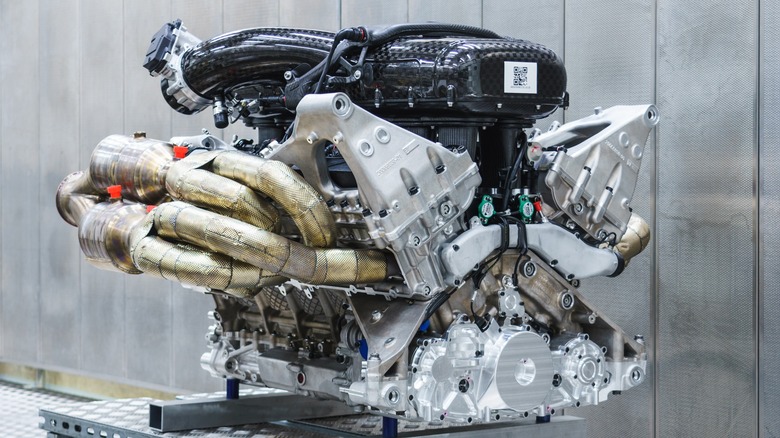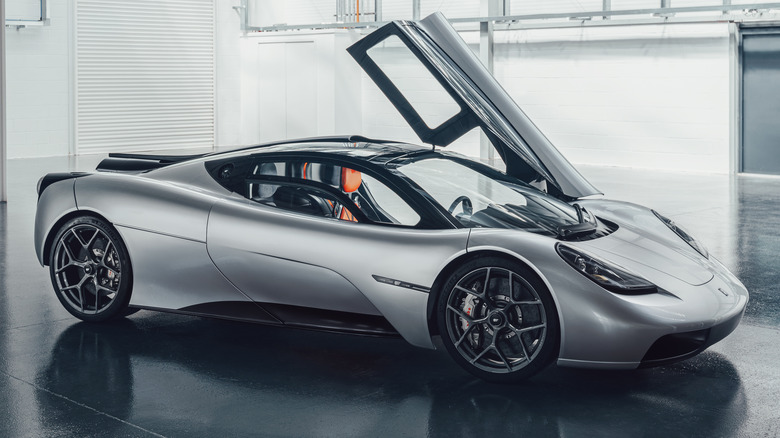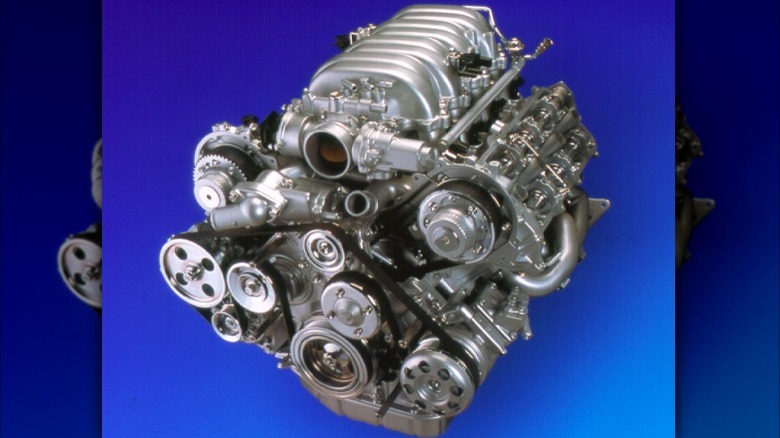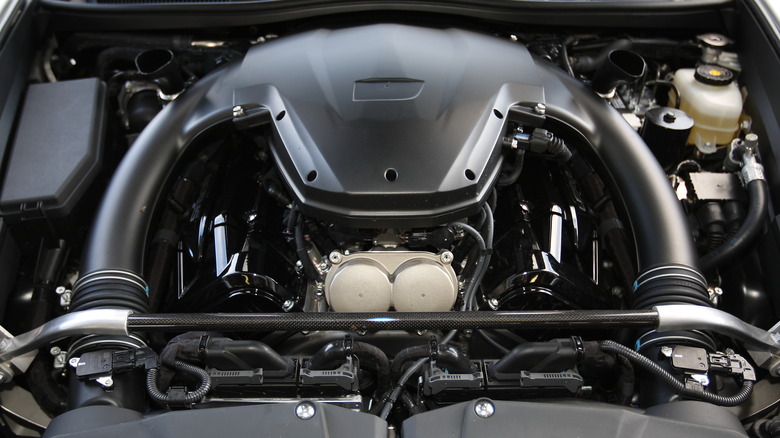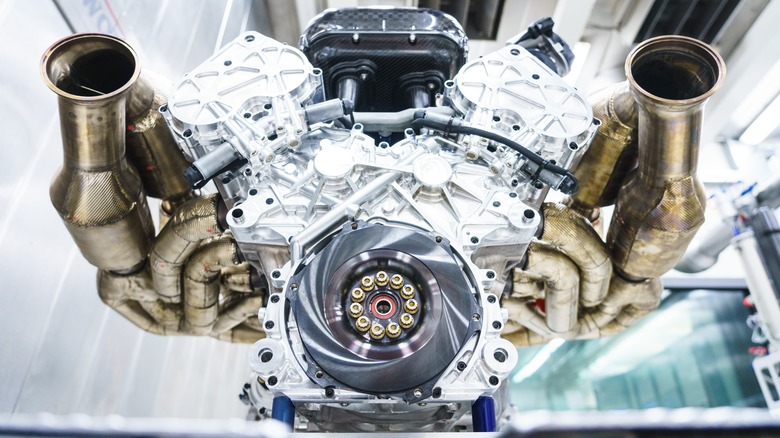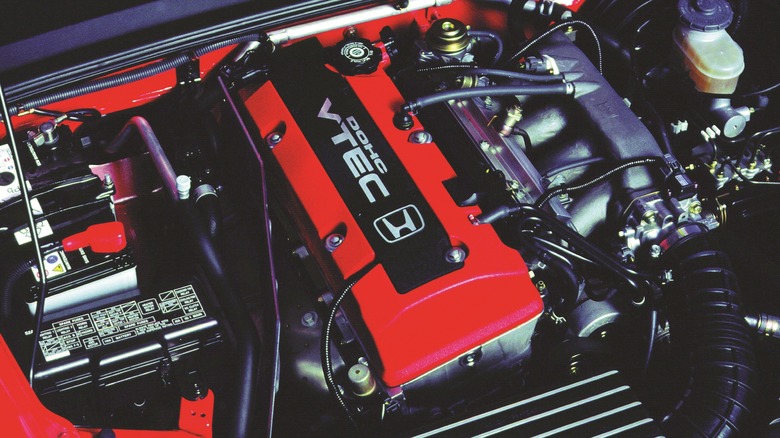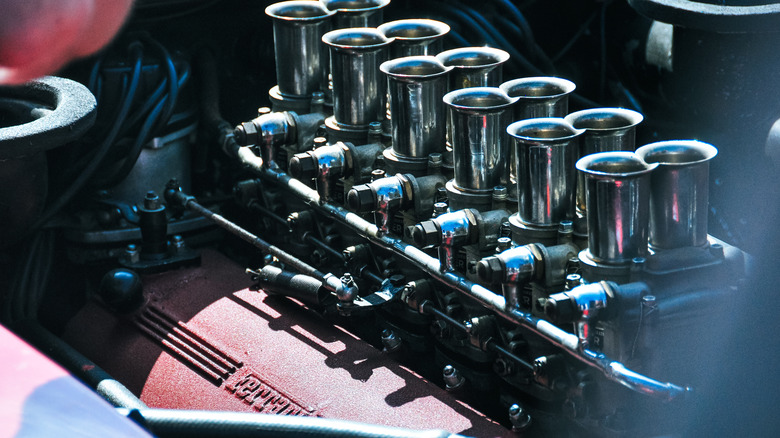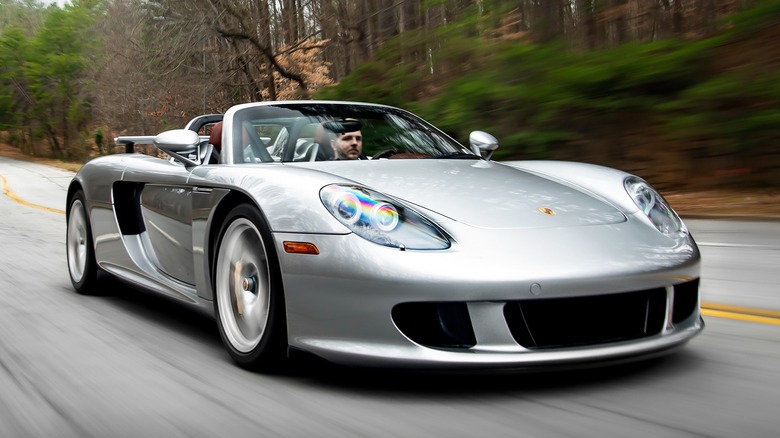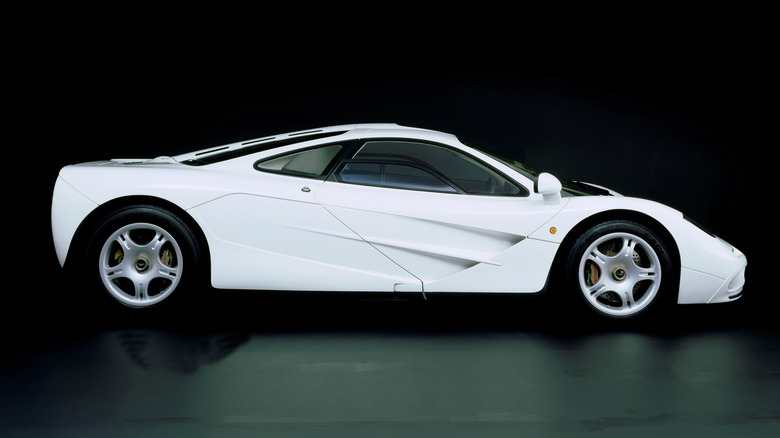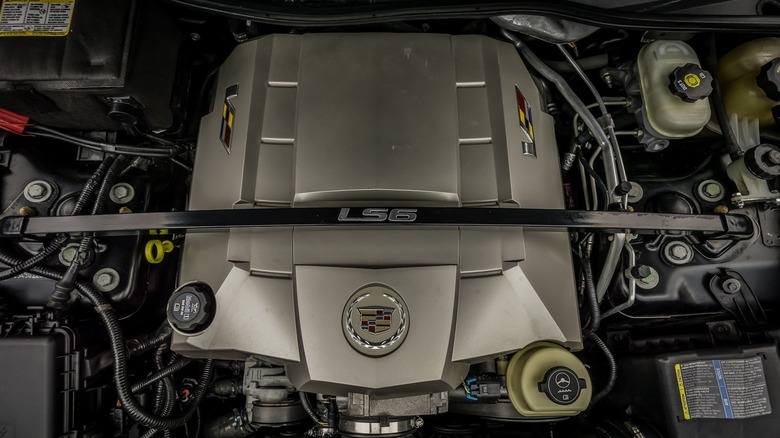10 Of The Most Impressive Naturally Aspirated Engines Ever Made
In the face of increasingly stringent emissions restrictions and rising gas prices, turbocharged engines seem like the obvious choice for car manufacturers. They allow for smaller displacement engines without compromising on overall power, and as a result they've become increasingly ubiquitous across all segments of the combustion car market. However, most enthusiasts will still have a soft spot for a great naturally aspirated engine.
The best of them boast thundering soundtracks and vast reserves of power while delivering the mechanical, connected driving experience that's increasingly difficult to find in modern cars. Well, modern affordable cars anyway -– as you'll see below, many of today's greatest hypercars still rely on engines without forced induction.
It's impossible to narrow down history's greatest naturally aspirated engines into one definitive list, so instead we've picked 10 of our favorites from past and present that offer particularly impressive power, pedigree, reliability, or a mix of all three. Each one was groundbreaking when it debuted and remains beloved by enthusiasts today.
Cosworth GMA V12
The bespoke heart of Gordon Murray's T.50 hypercar, the Cosworth GMA is unlike any V12 engine before it. That's true in the most literal sense: every single part of the engine was custom-designed for the project, with nothing shared with any other production engine. It's a magnet for superlatives, boasting the lightest weight, highest power density, and highest rpm limit of any V12 road car, according to Gordon Murray Automotive. The T.50 serves as the spiritual successor to Murray's most famous hypercar design, the McLaren F1.
The McLaren F1 pushed the boundaries of what was possible in terms of performance and design, while the T.50 moved those goalposts once again. Its 344 lb-ft of torque and 654 horsepower doesn't sound too groundbreaking at first, but considering it takes just 0.3 seconds for the engine to reach the rev limiter from idle, it's safe to say those initial numbers don't tell the full story. That redline, for context, sits at 12,100 rpm.
Only 100 examples of the road-legal T.50 have been built, so the chances for enthusiasts to actually see one of these exceptional engines in action are limited. Nevertheless, anyone lucky enough to be attending the likes of Goodwood or Pebble Beach should keep an ear out -– the T.50 possesses a howl like no other modern hypercar.
Toyota 1UZ-FE V8
The Toyota 1UZ-FE is not only one of the greatest engines of the 1990s, it's also arguably one of the best V8s ever made. That's primarily down to its ability to rack up seven-figure mileage with proper servicing, but it's also because of just how unlikely the engine's backstory was. In the early '80s, development began on what was to become the Lexus LS400. Toyota had never made a sedan so luxurious before, but the finished car was unveiled in 1989 and went on to become a critical and commercial success.
The V8 engine under its hood was developed especially for the car and featured more reinforcement than any other luxury car engine at the time, which allowed it to deliver unprecedented levels of reliability. It proved that Toyota, and by extension, Japanese manufacturers in general, could develop engines on par with the very best of what Europe and North America could offer, which was a key part of Lexus' success in both continents.
The 1UZ-FE is also extremely unusual for a road car engine in that it's also been used in both boats and aircraft. The latter is particularly unique, with Toyota first receiving permission from the FAA to supply aircraft engines in 1996 after partnering with American parts supplier Hamilton Standard.
Porsche Mezger flat-6
Porsche engineer Hans Mezger was involved in the development of many of the automaker's most revered cars, but the engine most often associated with his name is that found in the 996 and 997 generation 911 GT3. It was derived from the turbocharged engine found in the Le Mans-winning 911 GT1, but in road-going GT3 form, it was naturally aspirated. The flat-6 found in lesser variants of the 996 suffers from a variety of reliability problems that have left it the least desirable 911 generation, and Porsche was well aware of its flaws at the time.
Bosses needed a tougher engine to power the GT3 and so chose to adapt the GT1's race engine for road use rather than attempt to fix the flawed watercooled 996 engine. The Mezger flat-6 was proven in competition, and its design meant it wasn't susceptible to the regular 996's infamous IMS bearing failure. It proved to be the right choice for the GT3, delivering both ample power and a distinctive soundtrack, which led to it being subsequently used in both the GT2 and GT2 RS. It also saw service in Porsche's competition cars of the era, including the 911 RSR.
Toyota-Yamaha 1LR-FUE V10
The Lexus LFA is arguably one of the most overlooked supercars of its era. It was the result of an open-ended, blank-check project aimed at proving Toyota's place among the great automakers, although buyers weren't quite as convinced. Despite production of the car ending in 2012, unsold examples have hung around in dealerships for more than a decade, with one Australian example only being registered as sold in the summer of 2023. It's a strange state of affairs, especially considering the specially developed V10 engine at the heart of the LFA is one of the finest examples of its kind.
The engine was co-developed by Toyota and Yamaha while being built at the latter's factory at a rate of one unit per day. Each one was assembled entirely by hand by a single craftsman. It was rated at 552 horsepower with 354 lb-ft of torque and could reach its 9,000 rpm redline from idle in just 0.6 seconds.
All of this meant the LFA was wickedly fast, but perhaps most importantly for onlookers, it also boasted one of the best soundtracks of any modern supercar. Yamaha compares it to "the roar of an angel," although most onlookers won't get a chance to admire it for too long –- with a 0-60 mph time in the mid-three second range, it's not built to hang around.
Cosworth RA V12
The Aston Martin Valkyrie's V12 is the most powerful naturally aspirated engine ever made, with an output of 1,000 horsepower and a redline at 11,100 rpm. The engine was developed by Cosworth specifically for the car in collaboration with Red Bull. The partnership saw F1 construction methods incorporated into the assembly process, as well as a consistent focus on weight saving. Despite its 6.5L displacement, the V12 weighs just 454 lb, which makes it lighter per liter of displacement than Cosworth's F1 V10 engine. Not only that, but it's also a fully stressed chassis member, saving the need for additional reinforcement and reducing overall curb weight further.
Despite the lofty requirements put forward by program bosses, Aston Martin chose to stick to proven materials for its construction rather than using experimental alloys, as chief designer Adrian Newey reportedly didn't want to compromise on reliability. In fact, Newey refused to compromise on almost any aspect of the car or its engine, which reportedly pushed costs for the project way beyond expectations and left Aston Martin close to declaring bankruptcy. The Valkyrie might have nearly broken the company, but the end result is one of the most unique road cars to emerge this century.
Honda F20C four-cylinder
Under the hood of the Honda S2000 sat a four-cylinder engine with the highest specific output of any road car. It produced more horsepower per liter than any engine from Ferrari, Porsche, or even the mighty McLaren F1, yet it was still just as reliable as any other Honda. Internally called the F20C, the S2000's engine produced 237 horsepower at launch and could rev all the way up to a redline of 9,000 rpm.
Buyers would quickly find out that getting the best out of it required getting close to that limiter, too –- the engine was most alive at high revs and was criticized by some for lacking power in the lower half of its range. It wasn't universally liked at launch, but over time, even previous critics have had to concede that it remains a unique proposition in the affordable sports car segment.
No other four-cylinder has come close to matching its high-revving, VTEC-aided engine in the years since, and with the industry transitioning to electrification, it seems unlikely any future engines will either.
Ferrari Colombo V12
While many of the impressive engines here have been developed within the last few decades, the Colombo V12 can trace its history back to 1947 and the founding of one of the world's most legendary carmakers. Taking its name from its designer, Gioacchino Colombo, the V12 first debuted in the 125 S, the first car to be launched by the then-fledgling Ferrari brand. Initially, it featured a displacement of just 1.5L, but over the following decades, it would be gradually enlarged, reaching a maximum displacement of 4.9L.
Its status as one of history's greatest V12 engines is inarguable. It proved to be extremely competitive in racing and helped propel Enzo Ferrari's racing outfit from a plucky startup into a globally revered automotive powerhouse. It can be found powering many of Ferrari's most iconic classic race cars, including the 250 GTO, and boasted remarkable longevity, only being retired in the late '80s after more than four decades of production. As exceptional as it was, however, it's far from the only iconic engine put in a Prancing Horse.
Porsche 5.7L V10
The Porsche 5.7L V10 found in the Carrera GT is one of the brand's most celebrated powerplants, but it almost never saw the light of day. It was originally developed for endurance racing, with the plan being to enter a works car into the 2000 running of the 24 Hours of Le Mans. When the program was scrapped, the freshly-developed engine was left without a purpose, but bosses decided it shouldn't go to waste. Instead, they reasoned, why not put it into a road car? An initial prototype was unveiled in 2000, and the positive reception convinced Porsche to press ahead with production.
The V10 in the road car is remarkably similar to the one first developed for Le Mans duties. In fact, most of the changes were those needed to meet road regulations for noise and emissions. In addition, the V10's displacement was increased from 5.5L to 5.7L. The finished product produced more than 600 horsepower and could propel the Carrera GT to a top speed of 205 mph. In the end, it was never used for any further racing program, and after the 1,270 Carrera GT road cars were built, it was retired.
BMW S70/2 V12
The combination of power, agility, and double-digit rarity makes the roadgoing McLaren F1 one of the most valuable cars at auction today, as just 64 road-legal examples were built out of a total of 106 cars. The F1 offered unprecedented performance when it launched, combining race-inspired construction and materials with raw V12 horsepower. The V12 in question was the BMW S70/2, which produced around 620 horsepower from its 6.1L of displacement.
As well as being powerful, the engine was also surprisingly compact -– McLaren noted at the time of the car's release that, despite offering over 2.5L more displacement, the S70/2 was barely larger in dimensions than its F1 engines. It was light, too, thanks to the liberal use of cutting-edge materials like magnesium alloy and carbon fiber. This all added up to an engine that delivered seemingly endless reserves of power while being able to squeeze into the F1's compact chassis –- each of which took McLaren 3,000 hours to build.
GM LS V8
It might not boast the groundbreaking technology or million-dollar exclusivity of some of the other engines here, but GM's trusty LS V8 is arguably just as impressive. It's affordable, reliable, and can be modified to produce huge amounts of power, and that's made it the powerplant of choice for cars ranging from everyday family haulers to tire-shredding race cars.
The LS first appeared in the 1997 Chevy Corvette and is descended from the brand's long-serving small-block engine. It was retired two decades later in 2017, although can still be bought in crate form today. The comprehensive range of off-the-shelf aftermarket parts available means that it's still a top pick for project car builders looking for affordable power. It's proven to be both reliable and immensely versatile, and so will likely continue to be popular for many years, even though the LT has now taken the mantle as Chevy's production performance V8 of choice.
